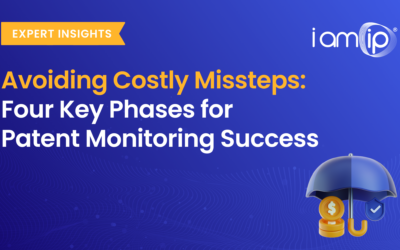
Owning patents is a significant competitive advantage for any technology-driven company. However, simply having patents in your portfolio isn’t enough.
Imagine installing an expensive home security system but never turning it on. That’s essentially what it means to hold patents without actively monitoring your competitors’ patent activity.
These days, business moves fast, and competition is fierce. Proactive patent monitoring is critical. It allows you to track which patents your competitors are filing, giving you a clear view of whether they are getting too close to your technology or messing with your intellectual property. Without keeping a close eye on things, you leave yourself vulnerable to infringement and unexpected challenges that can get in the way of your business growth.
Why Monitoring Competitor Patents Is Essential
Keeping an eye on competitors’ patents lets you notice their new technology and product plans early. It helps you:
- Identify potential infringement risks before products hit the market. Early detection means you can act before a product launch threatens your market share.
- Evaluate competitor innovation trends and adjust your research and development strategies accordingly. This insight can reveal new opportunities or warn of shifting market focus.
- Prepare for potential disputes well in advance, minimizing surprises and reducing costly, last-minute decisions.
Ignoring patent monitoring is like ignoring a warning light on your car’s dashboard. While it might seem like a small oversight at first, the damage can escalate quickly and prove very costly.
The Strategic Chess Game Before the Courtroom Drama
Contrary to popular media portrayals, IP disputes rarely start with a courtroom showdown. There’s a strategic “chess game” played behind the scenes before anyone says, “See you in court.”
The first step in this process is an internal assessment to understand the boundaries of your IP rights compared to your competitors’. This involves thorough research to find out if the competitor holds patents similar to your technology or is already selling potentially infringing products and in which markets.
If your assessment shows there might be infringement, you should respond with a clear plan for communication instead of rushing into a lawsuit.
Usually, it goes something like this:
- Your lawyer sends an infringement notice:
- The competitor may not have realized they were infringing and might agree to stop selling the product.
- Alternatively, they may want to continue selling and seek a license agreement, potentially creating a new revenue stream for you.
- The competitor disputes the claim:
- This can lead to a settlement negotiated out of court, saving both parties time and money.
- If no agreement is reached, the dispute may escalate to a court case, which is often costly and time-consuming, requiring significant resources.
Throughout this process, strategic communication and negotiation are key. Many disputes are resolved before reaching court, saving both sides substantial costs and preserving business relationships.
When Small Companies Take on Bigger Opponents
For smaller businesses, navigating IP disputes can be especially tough. Large corporations like Apple, Google, or Microsoft have extensive legal teams and financial resources that can sustain legal battles that drag on for months or even years.
In contrast, smaller companies often have limited legal support and resources. This disparity means smaller companies need to be particularly strategic:
- Early intervention is key. It’s far easier and less costly to challenge a patent during its application phase, before it’s approved. At this stage, you can submit evidence or raise objections to stop the patent from being approved.
- Influencing patent approvals early can stop competitors from getting patents that threaten your business, giving you a stronger defensive position.
Acting early not only saves money but also keeps competitors from shutting you out of key technologies or markets.
The Patent Office Doesn’t Protect Your Rights
Many companies mistakenly assume patent offices act as guardians of their IP rights, but this is not the case. Patent examiners focus on making sure a patent application is new and shows real creativity. Their job is not to monitor ongoing patent infringement or protect existing patents.
For example, one of our customers discovered through their patent monitoring tool that a collaboration partner in China had filed patents on technology they developed together without informing them. Without monitoring, this infringement would have gone unnoticed, potentially costing the customer valuable IP rights and competitive advantage.
Situations like this highlight why it’s so important to keep a close watch and stay alert in every market where your technology matters.
Business Is Ruthless, Your IP Monitoring Should Be Too
In the real world, there are no gentlemen’s agreements. Business competition can be rough, and companies may take aggressive steps to protect or advance their market position, sometimes at your expense.
Patents and an effective IP monitoring platform give you the power to assert yourself confidently in the marketplace. They help you:
- Set clear boundaries around your intellectual property.
- Detect early signs when competitors step onto your “lawn”.
- Protect your rights early and thoughtfully to stop small problems from turning into expensive lawsuits.
Without staying alert, you put your business at risk of IP theft, losing customers, and costly litigation that could have been avoided with early action.
Takeaway: Don’t Just Own Patents, Use Them Wisely
Patents are more than just legal documents; they are strategic assets. But their value is only realized when combined with active competitor monitoring, strategic planning, and timely action.
To keep your innovation safe and stay one step ahead, it’s important to:
- Implement a patent monitoring system that covers all relevant jurisdictions.
- Regularly check your IP portfolio to see what is strong and what might be a weak spot.
- Develop a clear strategy for handling potential infringement, including how you’ll communicate and when to take things to the next level.
The business world moves fast, and so do your competitors. Don’t let your patents become an unused security system. Turn them on and keep your IP safe.
insights by: Dimitris Giannoccaro
Search
Categories
- Announcement 11
- Case Study 1
- Expert Insights 10
- IamIP News 6
- Industry Trends 31
- Innovation Index 4
- New Release 13
- Platform News 2
- Press Release 1
- Uncategorized 1
- Webinar 16





